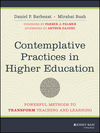Contemplative Practices in Higher Education: Powerful Methods to Transform Teaching and LearningISBN: 978-1-118-43527-4
256 pages
January 2014, Jossey-Bass

US $42.00
This price is valid for United States. Change location to view local pricing and availability. More Press Releases in: |
CONTEMPLATIVE PRACTICES IN HIGHER EDUCATION: Powerful Methods to Transform Teaching and Learning
The interest in contemplative practices in higher education has never been greater and is increasing each year. Practices are used in just about every field. In the sciences, there are contemplative courses in physics, chemistry, and neuroscience as well as in the social sciences, history, economics and political science. There are also courses in the arts, including English literature, music, medieval studies, art history, and in professional schools of medicine, law, business, and architecture. They are found in every type of institution, including community colleges, four-year colleges, universities, medical schools, historically black colleges, and law and business schools. Each year more and more faculty, education reformers, and leaders of teaching and learning centers seek information and attend sessions about the use of contemplative practices.
CONTEMPLATIVE PRACTICES IN HIGHER EDUCATION: Powerful Methods to Transform Teaching and Learning (Jossey-Bass, a Wiley brand; December 2013; $38; Paper and available as an eBook; ISBN: 9781118435274) presents the background and application of contemplative practices. Remarkably, they are used throughout the curriculum. Contemplative pedagogy is more than a new, trendy technique to change the landscape of learning. Rather, it is the use of first-person involvement to—
- develop and deepen sophisticated problem-solving,
- empower students in integrating their own experience and lives into theoretical material they are being taught and thereby deepen and extend understanding,
- support the sense of connection and compassion within and among students and the rest of the world, and
- Engender inquiries into students' most profound questions.
Examples of techniques in CONTEMPLATIVE PRACTICES IN HIGHER EDUCATION include: mindfulness; meditation; yoga; deep listening; contemplative reading and writing; and pilgrimage, site visits, and field trips. With an expert author team and Foreword and Afterword by two distinguished thought leaders, CONTEMPLATIVE PRACTICES IN HIGHER EDUCATION is a must-read for faculty, faculty developers, administrators and student affairs staff interested in using contemplative practices with students.


